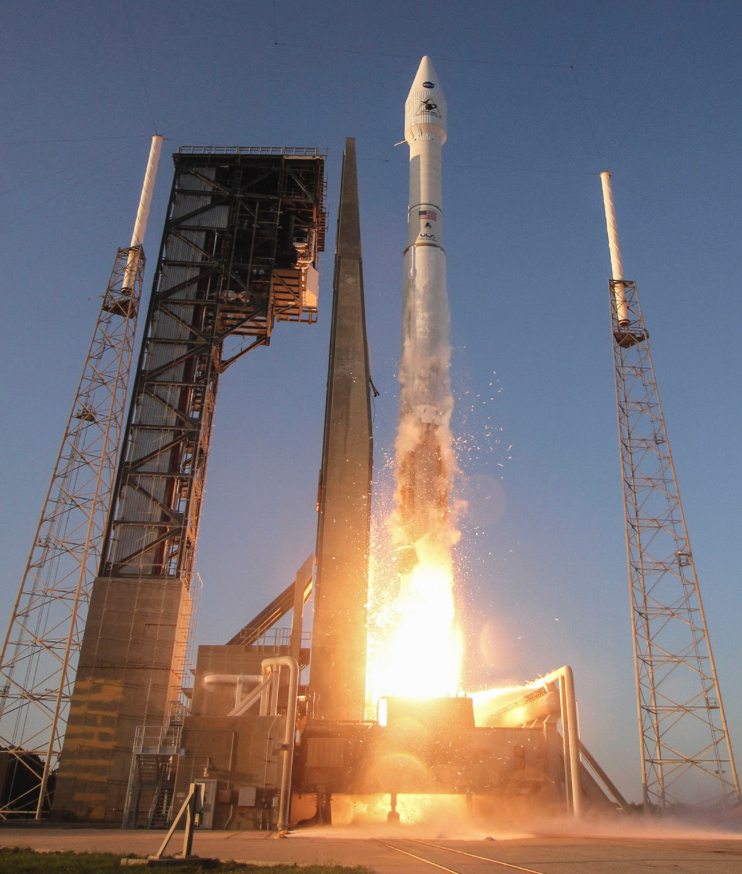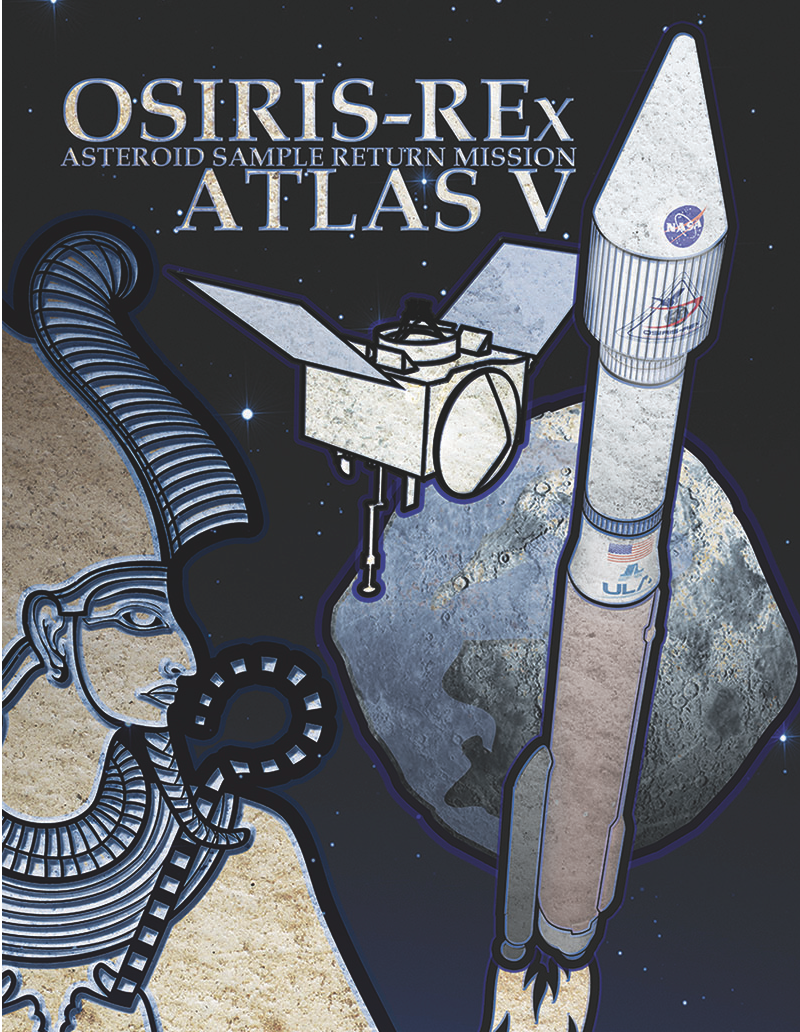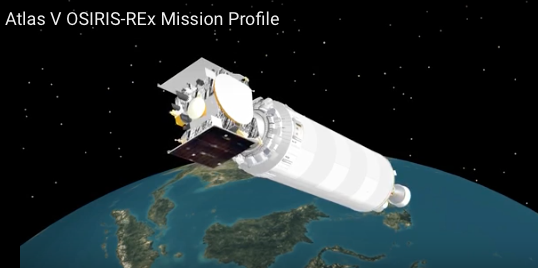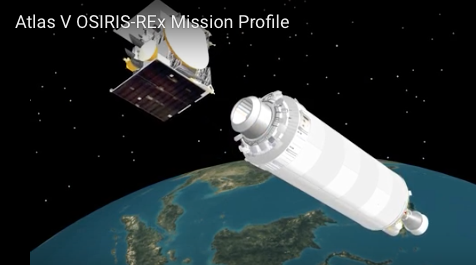

Cape Canaveral Air Force Station, Florida. (September 8, 2016) – A United Launch Alliance (ULA) Atlas V rocket carrying the OSIRIS-REx spacecraft lifts off from Space Launch Complex-41 at 7:05 a.m. EDT. Photo by United Launch Alliance
ULA's Statement
Cape Canaveral Air Force Station, Florida, (September 8, 2016) – A United Launch Alliance (ULA) Atlas V rocket carrying the OSIRIS-REx spacecraft for NASA lifted off from Space Launch Complex-41 September 8 at 7:05 p.m. EDT. The Atlas V launched the OSIRIS-REx spacecraft into a hyperbolic trajectory away from Earth where it will begin a seven-year mission to return an asteroid sample. This is ULA’s eighth launch in 2016 and the 111th successful launch since the company was formed in December 2006.
“We are honored to be chosen by NASA to launch this historic mission,” said Laura Maginnis, ULA vice president of Custom Services. “Thank you to our NASA customer and mission partners for the outstanding teamwork and attention to detail as we successfully started OSIRIS-Rex on its seven-year journey to Bennu.”
This mission was launched aboard an Atlas V Evolved Expendable Launch Vehicle (EELV) 411 configuration vehicle, which includes a 4-meter large Payload Fairing (PLF). The Atlas booster for this mission was powered by the RD AMROSS RD-180 engine, and the Centaur upper stage was powered by the Aerojet Rocketdyne RL10A engine.
“ULA and our heritage vehicles have successfully launched NASA missions to every planet in our solar system,” said Maginnis. “ULA’s commitment to mission launch is unparalleled, and we’re proud of our team for continuing our unprecedented track record of 100 percent mission success.”
This mission was launched aboard an Atlas V Evolved Expendable Launch Vehicle (EELV) 411 configuration vehicle, which includes a 4-meter-diameter large payload fairing. The Atlas booster for this mission was powered by the RD AMROSS RD-180 engine, and the Centaur upper stage was powered by the Aerojet Rocketdyne RL10A engine.
ULA's next launch is the Atlas V WorldView-4 satellite for Lockheed Martin and DigitalGlobe. The launch is scheduled for September 16 from Space Launch Complex-3 at Vandenberg Air Force Base, California.
With more than a century of combined heritage, United Launch Alliance is the nation’s most experienced and reliable launch service provider. ULA has successfully delivered more than 100 satellites to orbit that provide critical capabilities for troops in the field, aid meteorologists in tracking severe weather, enable personal device-based GPS navigation and unlock the mysteries of our solar system.
End ULA's Statement

Mission Description: The OSIRIS-REx mission will help scientists investigate the origins of our solar system, how water and organic material traveled to Earth, and increase understanding of asteroids that could impact Earth. In addition, the sample returned to Earth will further our understanding of water, organics and precious metals on asteroids, which could fuel future exploration missions.

Launch Notes: OSIRIS-REx marks the 65th Atlas V launch and the fourth in the 411 configuration. This also will be ULA’s 111th launch since the company was formed in 2006.
NASA's writeup regarding the mission is as follows can be found here:
The first U.S. mission to travel to an asteroid, retrieve samples and return them to Earth is targeted for a September 8 launch atop a United Launch Alliance Atlas V rocket from Cape Canaveral Air Force Station in Florida. This groundbreaking mission, several years in the making, is the Origins, Spectral Interpretation, Resource Identification, and Security-Regolith Explorer, also known as OSIRIS-REx. It will travel to near-Earth asteroid Bennu, map its surface using 3-D laser imaging, retrieve samples from the surface and return to Earth.

“The OSIRIS-REx mission is a seven-year journey from launch to Earth return,” said Dante Lauretta, principal investigator. He is a professor at the Lunar and Planetary Laboratory at the University of Arizona.
The spacecraft will spend the first two years of the mission cruising to asteroid called Bennu (formerly 1999 RQ36) arriving in August 2018. The five specialized instruments on OSIRIS-REx will be used to map the asteroid’s surface, identify the minerals and chemicals that may be on the surface, and select the sample site.
“The primary objective of the mission is to bring back 60 grams of pristine carbon-rich material from the surface of Bennu,” Lauretta said. “We expect these samples will contain organic molecules from the early solar system that may give us information and clues to the origin of life.”
In July 2020, the spacecraft will briefly touch the surface of the asteroid to collect loose rocks and dust using its Touch-and-Go Sample Acquisition Mechanism, or “TAGSAM,” and store the material in a sample return capsule. The spacecraft will depart the asteroid in March 2021, when the departure window opens, and travel for two-and-a-half years on a trajectory for Earth return in September 2023.
As OSIRIS-REx approaches the Earth, the sample return capsule will eject from the spacecraft and land with the help of parachutes at the Utah Test and Training Range, southwest of Salt Lake City. The canister will be retrieved and transported to NASA’s Johnson Space Center in Houston for analysis. The main OSIRIS-REx spacecraft will remain in orbit around the Sun after the sample return and Earth flyby. The mission will lay the groundwork for future exploration of asteroids and other small bodies in the solar system.
Prior to launch, the appropriate steps are being taken to assure mission success. The remainder of this informative article can be found here.

